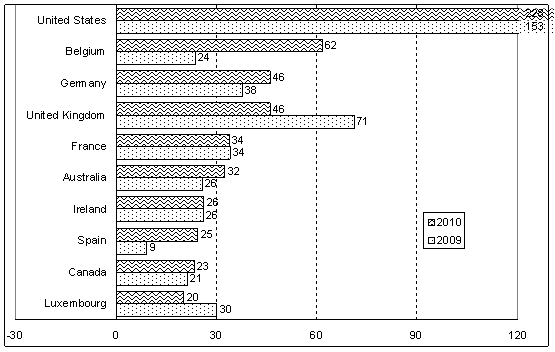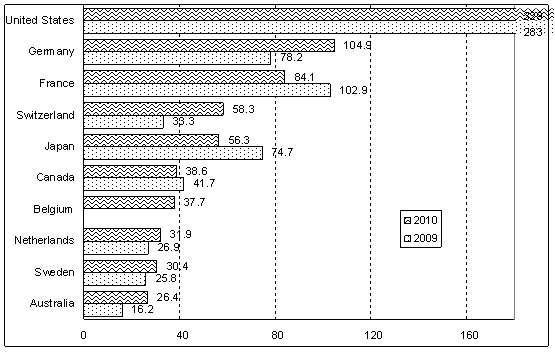| EMBARGO The contents of this press release and the related Report must not be quoted or summarized in the print, broadcast or electronic media before 26 July 2011,17:00 [GMT] (13:00 New York; 19:00 Geneva, 22:30 New Delhi, 02:00 - 27 July Tokyo) |
Geneva, 26 July 2011 - FDI inflows to developed countries in 2010 declined marginally to $602 billion, UNCTAD´s survey of global investment trends reveals.
The World Investment Report 2011(1) (WIR11), subtitled "Non-equity modes of international production and development", was released today.
The annual survey finds that the pattern of FDI inflows was uneven within the region. Europe stood out as the subregion where flows fell most sharply. Inflows to Europe were $313 billion, a fall of 19 per cent from 2009. A gloomier economic outlook prompted by government austerity measures and a looming sovereign debt crisis were among the factors hampering the recovery of FDI. Declining FDI flows were also registered in Japan, where net inflows turned negative (-$1.25 billion) due to large divestments by foreign transnational corporations. In contrast, inflows of FDI to North America showed a strong turnaround, with an increase of 44 per cent to $252 billion.
FDI outflows from developed countries reversed their downward trend since 2008 with a 10 per cent increase in 2010. WIR11 notes, however, that despite the sizeable recovery of $935 billion, outflows of FDI from the region as a whole in 2010 were half of their peak in 2007.
As for trends in 2011, available data on mergers and acquisitions (M&As) and greenfield projects for the early part of the year are encouraging. The report notes, however, that risks remain with regard to the growth prospects of major economies in the region, including the United States. Shifts in these prospects could still derail the recovery of FDI.
This year´s report sheds light on FDI flows in the banking industry in the region. Following the collapse of Lehman Brothers in September 2008, a number of international banks were bailed out by governments. The subsequent restructuring of the banking industry, driven by regulatory authorities, has resulted in a series of significant divestments of foreign assets. At the same time, restructuring has generated new FDI as those banks that emerged relatively strongly from the crisis acquired the assets of weaker banks abroad. In addition, private equity funds, mostly based in the United States, were active participants in the restructuring process. In the longer term, global efforts to reform the financial system and the strategies of governments exiting from the recession are likely to have large effects on FDI flows in the financial industry.
The World Investment Report and its database are available online at http://www.unctad.org/wir and http://www.unctad.org/fdistatistics and http://www.unctad.org/diae |
Overview in French
Overview in Spanish
Overview in Arabic
Overview in Russian
Overview in Chinese
ANNEX
Tables and figures
Figure 1. Developed countries: top 10 recipients and sources of FDI flows, 2009-2010(Billions of dollars)
a) Inflows

b) Outflows

Source: UNCTAD, World Investment Report 2011.
Note:Countries ranked on the basis of the magnitude of 2010 FDI flows.


